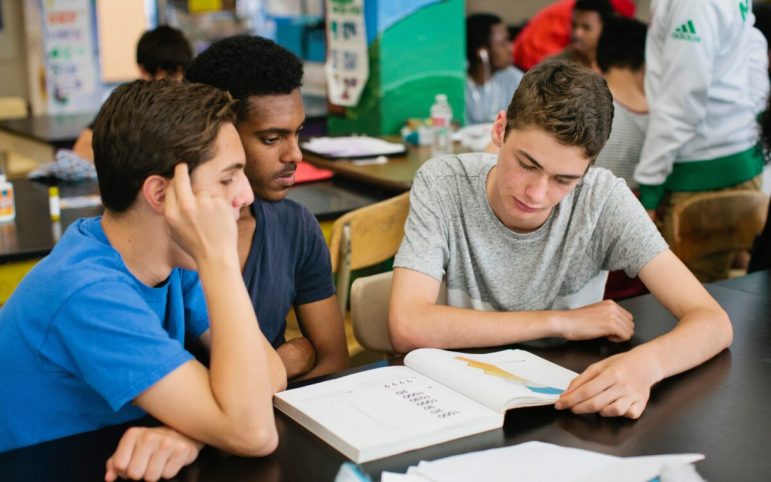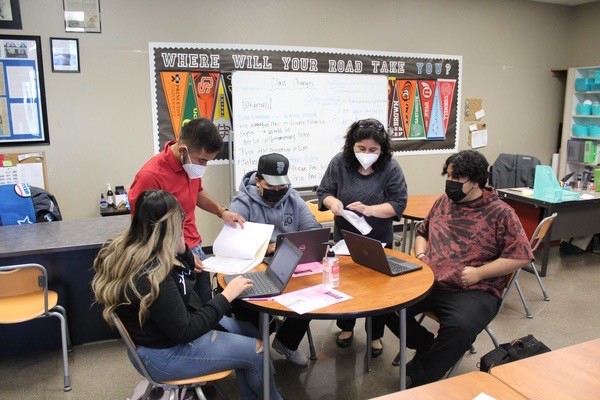More California high school students applied for free federal and state financial aid for college this year than last —likely showing that a new state law is having a positive effect.
Researchers with the state Student Aid Commission credit the boost to a new state law that required high schools to highly encourage students to complete the Free Application for Federal Student Aid, or FAFSA, which states also use to determine financial aid under state programs. The goal of the law is to inform more students that they can receive substantial aid and encourage them to attend college.
Among new high school filers, more than 450,000 students submitted a FAFSA application this year — a 17.5% increase from last year, according to the commission. The state’s high schools also saw nearly 8,000 students submit Dream Act applications, a 1.6% increase from last year. The Dream Act application allows students who are undocumented to receive state financial aid. Those students do not qualify for federal aid.
Overall, statewide, FAFSA applications for new and returning college students increased by 5.9% to 1,184,850 submissions. The deadline to submit applications in California was March 2. Nationally, as of March 3, 42.7% of the Class of 2023 have completed a FAFSA, a 5% increase from last year, according to the National College Attainment Network.
“This is a significant increase, and we are really pleased with that number because we had been seeing such deep declines since the onset of the pandemic,” said Marlene Garcia, executive director of the California Student Aid Commission.
“When you compare this to the last so-called normal pre-pandemic data, the increase isn’t as big, but it’s still moving in the right direction.”
COVID had a clear impact on high school seniors. For example, the Class of 2021 had 190,000 fewer FAFSA completions compared to the Class of 2019.
Garcia said the boost in completions this year can be attributed to the new state requirement for high schools to do as much as they can to help students complete the application.
“It is a big change for them,” she said. “Normally local high school counselors deal with the students who, by and large, self-identify and say they’d like to go to college or those that they call in or invite to the college fairs.”
But this year, all students were required to complete the application, including those who haven’t taken the so-called A-G courses, those who don’t do well academically or may think they’re not college material, Garcia said. A-G courses are a series of required classes California high school students take to be eligible for admission to a University of California or California State University campus.
The application is used for such state programs as Cal Grants and for federal ones, including Pell Grants, work-study and loans.

“It was a pretty easy process just because we had counselors come into our classes and they basically gave us a rundown of how to fill out the FAFSA and how to navigate the website,” said Isabella Campbell, a 17-year-old senior at Centennial High School in Corona in Riverside County. Campbell has already been accepted to three California universities and is awaiting decisions from six more.
“We had a night at our school where we had a huge workshop, and a bunch of school counselors were there helping students navigate the portals for their colleges and fill out the FAFSA,” she said.
Josh Godinez, a counselor at Centennial High in Corona and former board co-chair of the state association of school counselors, said it helped to be able to tell students and families starting in the spring of last year that completing the application now was part of the law.
“It’s no longer an option,” he said. “It’s an expectation that we all have this done.”
Assembly Bill 469, which Gov. Gavin Newsom signed into law in 2021, mandates that school districts, charter schools and county offices of education require high school seniors to complete the FAFSA or Dream Act application. It allows, however, for parents and students over age 18 to complete an opt-out form so they can skip the FAFSA.
Loretta Whitson, executive director of the California Association of School Counselors, said it helped that counselors across the state had about a year to prepare for the requirement and that many of them had already been encouraged by efforts during the Obama administration to promote free financial aid and college.
“We really pushed hard throughout the state to acknowledge that we needed to do more as a profession,” Whitson said. “I found that school counselors were very much talking about it. We had workshops on it. We had presentations on it. It became something that I saw on social media where school counselors were posting their FAFSA completion rates and there was a kind of mini competition going on.”
Godinez said that some of the high school students did choose to formally opt out. Those students often cited their decisions to join the military, work for their family businesses or take a gap year pursuing missionary or volunteer work for religious beliefs as reasons to not apply for the FAFSA this year.
Despite the push, completing the FAFSA is still a complicated task for some students and their families, who must find and submit tax returns as part of the process, according to Whitson.
And the task may become more difficult next year. The federal Education Department announced last week that the 2024-25 FAFSA application deadline will be delayed to December. The federal student aid application season typically begins Oct. 1, with many students applying for financial help during the fall.
“That means we (may) lose October, November and December for students to complete,” Garcia said, adding that the commission and counselors are exploring how to get students ready if there is a delay.
